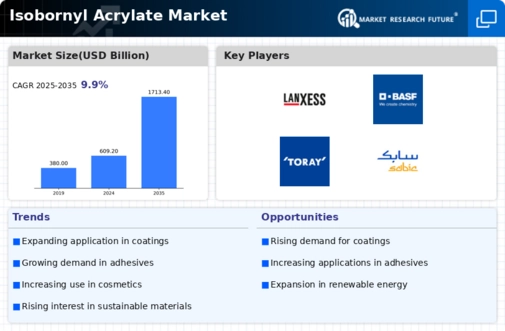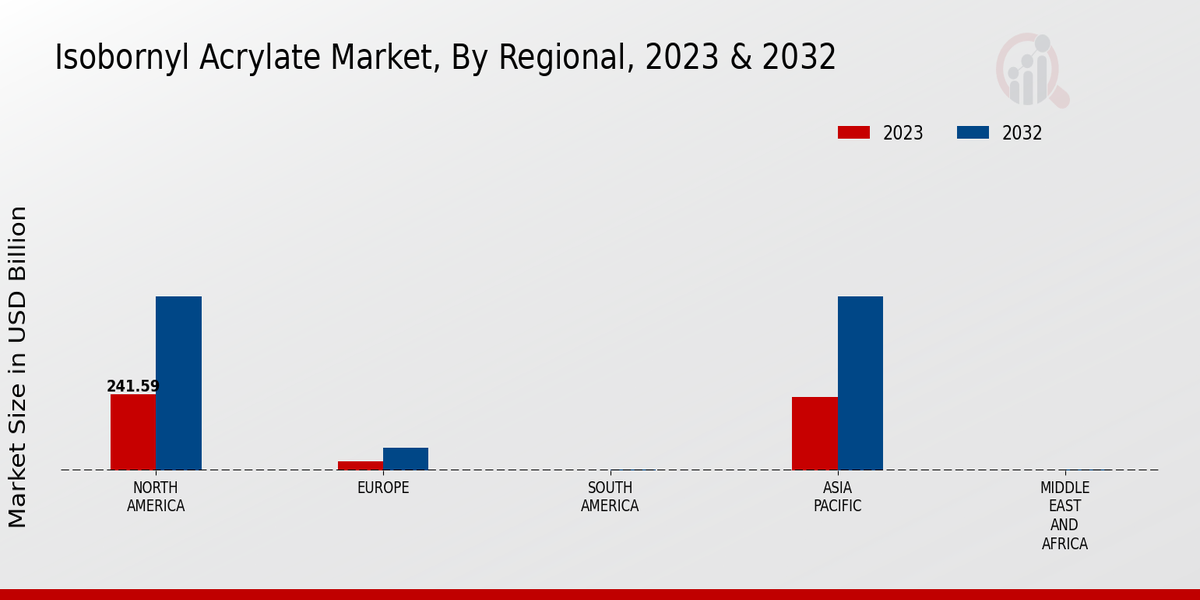Rising Environmental Regulations
The Global Isobornyl Acrylate Market Industry is also influenced by the rising environmental regulations aimed at reducing volatile organic compounds in industrial applications. As manufacturers strive to comply with stringent regulations, there is a growing preference for low-emission materials, including isobornyl acrylate. This shift not only aligns with regulatory requirements but also caters to the increasing consumer demand for sustainable products. Consequently, the market is expected to benefit from this trend, as companies invest in developing eco-friendly alternatives that utilize isobornyl acrylate, thereby enhancing its market position.
Increasing Applications in 3D Printing
The Global Isobornyl Acrylate Market Industry is witnessing a notable increase in applications within the 3D printing sector. As additive manufacturing technologies advance, the demand for high-quality resins that offer excellent mechanical properties is on the rise. Isobornyl acrylate, known for its versatility and performance, is becoming a favored choice among manufacturers of 3D printing materials. This trend is indicative of the broader shift towards innovative manufacturing processes, which are expected to drive market growth significantly in the coming years. The integration of isobornyl acrylate in 3D printing applications could potentially reshape the landscape of the market.
Growing Demand from Adhesives and Coatings
The Global Isobornyl Acrylate Market Industry experiences a robust demand surge from the adhesives and coatings sector. This growth is primarily driven by the increasing need for high-performance materials in various applications, including automotive, construction, and electronics. As industries prioritize durability and resistance to environmental factors, isobornyl acrylate's unique properties make it a preferred choice. The market is projected to reach 609.2 USD Billion in 2024, reflecting a significant uptick in consumption. Furthermore, the anticipated expansion of the construction sector globally is likely to further bolster the demand for coatings, thereby enhancing the market's growth trajectory.
Technological Advancements in Polymer Chemistry
Technological advancements in polymer chemistry are playing a pivotal role in shaping the Global Isobornyl Acrylate Market Industry. Innovations in synthesis techniques and formulation processes are enhancing the performance characteristics of isobornyl acrylate, making it more appealing for various applications. For instance, the development of eco-friendly formulations and the ability to tailor properties for specific applications are driving its adoption across multiple sectors. As a result, the market is likely to witness a compound annual growth rate of 9.86% from 2025 to 2035, reflecting the impact of these advancements on overall market dynamics.
Expansion of the Cosmetics and Personal Care Sector
The Global Isobornyl Acrylate Market Industry is significantly influenced by the expansion of the cosmetics and personal care sector. With consumers increasingly seeking innovative and high-quality products, manufacturers are incorporating isobornyl acrylate into formulations for its excellent film-forming properties and stability. This trend is particularly evident in the production of nail polishes, skincare products, and hair care formulations. As the global cosmetics market continues to flourish, projected to reach substantial figures by 2035, the demand for isobornyl acrylate is expected to rise correspondingly, indicating a promising outlook for the industry.






